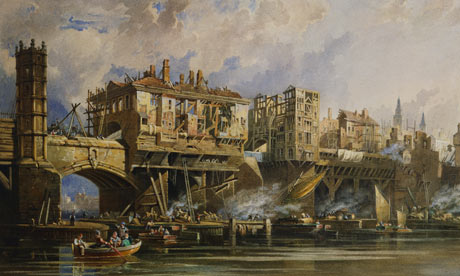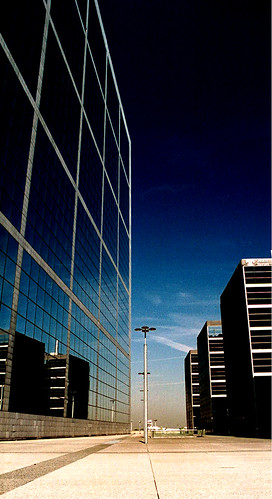Maximus may have been all fish-out-of-water proposing an inhabited viaduct over Wellington’s the Basin Reserve over at Eye of the Fish, but it seems that somebody is reading that blog over in our good old Mother Country… Boris Johnson, Lord Mayor of London no less…

As Jonathon Glancey writes for the Guardian:
The idea of building a new bridge across the Thames lined with shops and houses, just like Old London Bridge, the one “falling down, falling down” in nursery rhyme lore, is a well worn one. This is one of those hardy perennials in the world of eye-popping design projects, one that refuses to go the way Old London Bridge did soon after its successor opened in 1831. It has now been revived by the London mayor, Boris Johnson.
Like Boris, and very unlike Glancey (the Guardian’s architectural columnist), our fishy friends are all in a frenzy for such ticky tacky structures (Glancey’s take on them), and provide some alluring eye-candy in support of their upstream position.
Glancey’s main issue (beyond the lack of an architectural imagination), is the time it takes to cross one these inhabited structures – he describes the infamous London Bridge as if he were there, and similarly disparages the Venice’s Rialto, and Florence’s Ponte Vecchio. This might well be an issue in the proposed inhabited Basin flyover, which is somewhat contradictory to its rationale for a more efficient transportation network, but for a new London Bridge, could be something of a draw card. The ‘problem’ isn’t really that of inhabited structures anyway – it has more to do with such bridges being on modern day tourist routes – the ‘uninhabited’ Charles Bridge in Prague is a case in point – the peak tourist congestion is something to behold…
This just shows that Glancey’s ideal:
Most of us would surely prefer to cross a beautiful, open bridge offering fresh air and inspiring views of London
…could surely be just as impractical, by his own definition of bridge function, as any inhabited structure might be. Luckily Londoners already have a series of open pedestrian-catering bridges over the Thames, including the Foster’s infamous wobbly bridge.

But it is not the bridges, inhabited or otherwise, that intrigue me about Glancey’s position, it is his notion that the ‘best’ way to get from A to B is via the straight line – the most efficient route. This a priori notion colours his evaluation of the new London Bridge proposal, prompting his dismissive response, but also revealing the Modernist within. After all, it was Le Corbusier who said:
Man walks in a straight line because he has a goal and knows where he is going […]. The pack-donkey meanders along, meditates a little in his scatter-brained and distracted fashion, he zigzags in order to avoid the larger stones, or to ease the climb, or to gain a little shade; he takes the line of least resistance…

To stay for all your life a free thinker: this is the meaning of Slow living; to have the courage to stop, ponder and made your own choices before external events and trends will sweep you away.
I’m all for slowness (even if it makes me an ass) – it seems to me that the more instantaneous we make things – such as communication – the poorer the quality of those ‘things’. Where is the value in being ‘tweeted’ – no really? Photography is my favourite hobbyhorse – the advent of digital cameras saw a vast drop in image quality. The much-desired instantaneous of image capture supplanted image quality to the degree that eventually hyper-saturation and hyper-sharpness overtook detailed subtlety and thoughtful craft as the digital medium, in its earlier stages, could not produce the latter qualities. Now we are going through the whole process again with the instantaneousness of mobile phone cameras. Sure, we get images where we may not have before, but looking at most of them, is it really worth it? Like digital cameras, our mobile phone cameras will get better, but the art of slow photography will be well-lost by that stage, as we point and shoot at any eye-candy that we happen to be passing by… (kind of the equivalent of the construction worker’s wolf whistle – superficial, meaningless, and in bad taste).
Back on topic: Corbusier’s (and Glancey’s) totalitarian stance does not allow for the meanderer, the slow walker, the flaneur, or the tourist. We know the type of public spaces that have resulted from Corb’s urban theory, and the vast amount of effort in the subsequent decades that has gone into relearning how built environments can foster the type of social interaction that was eliminated from the functionalist city and their vast plazas of emptiness, to be crossed at high speed from point A to point B.
The Art of Slow Living also, of course, makes the 2-3 minutes that we might save by having a Basin Fly-over in the first place seem rather an extravagant waste of gaining time.
Similarly, the proposed London Bridge – inhabited rather than simply being another thoroughfare over the Thames (of which there are numerous examples anyway), may ‘cost’ the pedestrian several extra minutes as they travel from one side to the other, but surely the benefits of the creation of a ‘place’ far outweigh this – a place that supports commerce, social interaction, and life in all its messy vitality. Helmut Einhorn once proposed a similar ‘place’ as a bridge over the Wellington Urban Motorway when he was working on that project. It consisted of gardens and public spaces than actual buildings, but the concept is the same. Wellington’s City to Sea Bridge also attempts to evoke such concepts to transcend the simple thoroughfare function of a bridge, with arguably some success.
That Glancey can still base his architectural criticism from a purely functionalist stance today is a little bit disappointing – given his position. Does he disagree with Jane Jacobs, William Whyte, even Jan Gehl, and a whole host of other urban observers who have spent so much time and effort in trying to get us to see where we went wrong in our postwar cities? We might be the pack-donkeys, but in my view, Glancey is almost certainly the jackass…

And you run and you run to catch up with the sun, but its sinking
And racing around to come up behind you again
The sun is the same in the relative way, but you’re older
Shorter of breath and one day closer to deathPink Floyd





Leave a Reply